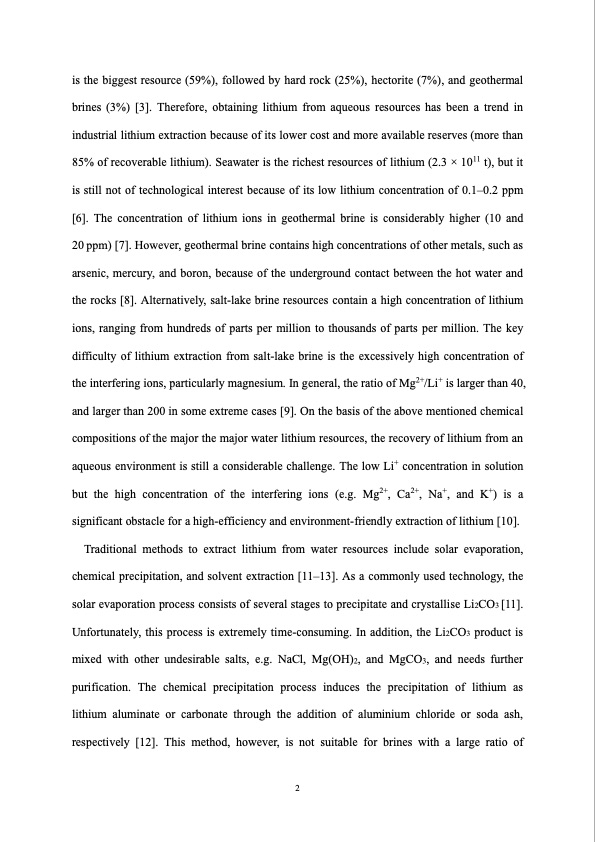
PDF Publication Title:
Text from PDF Page: 006
is the biggest resource (59%), followed by hard rock (25%), hectorite (7%), and geothermal brines (3%) [3]. Therefore, obtaining lithium from aqueous resources has been a trend in industrial lithium extraction because of its lower cost and more available reserves (more than 85% of recoverable lithium). Seawater is the richest resources of lithium (2.3 ×1011 t), but it is still not of technological interest because of its low lithium concentration of 0.1–0.2 ppm [6]. The concentration of lithium ions in geothermal brine is considerably higher (10 and 20 ppm) [7]. However, geothermal brine contains high concentrations of other metals, such as arsenic, mercury, and boron, because of the underground contact between the hot water and the rocks [8]. Alternatively, salt-lake brine resources contain a high concentration of lithium ions, ranging from hundreds of parts per million to thousands of parts per million. The key difficulty of lithium extraction from salt-lake brine is the excessively high concentration of the interfering ions, particularly magnesium. In general, the ratio of Mg2+/Li+ is larger than 40, and larger than 200 in some extreme cases [9]. On the basis of the above mentioned chemical compositions of the major the major water lithium resources, the recovery of lithium from an aqueous environment is still a considerable challenge. The low Li+ concentration in solution but the high concentration of the interfering ions (e.g. Mg2+, Ca2+, Na+, and K+) is a significant obstacle for a high-efficiency and environment-friendly extraction of lithium [10]. Traditional methods to extract lithium from water resources include solar evaporation, chemical precipitation, and solvent extraction [11–13]. As a commonly used technology, the solar evaporation process consists of several stages to precipitate and crystallise Li2CO3 [11]. Unfortunately, this process is extremely time-consuming. In addition, the Li2CO3 product is mixed with other undesirable salts, e.g. NaCl, Mg(OH)2, and MgCO3, and needs further purification. The chemical precipitation process induces the precipitation of lithium as lithium aluminate or carbonate through the addition of aluminium chloride or soda ash, respectively [12]. This method, however, is not suitable for brines with a large ratio of 2PDF Image | Membrane based technologies for lithium recovery from water lithium

PDF Search Title:
Membrane based technologies for lithium recovery from water lithiumOriginal File Name Searched:
Content.pdfDIY PDF Search: Google It | Yahoo | Bing
Product and Development Focus for Infinity Turbine
ORC Waste Heat Turbine and ORC System Build Plans: All turbine plans are $10,000 each. This allows you to build a system and then consider licensing for production after you have completed and tested a unit.Redox Flow Battery Technology: With the advent of the new USA tax credits for producing and selling batteries ($35/kW) we are focussing on a simple flow battery using shipping containers as the modular electrolyte storage units with tax credits up to $140,000 per system. Our main focus is on the salt battery. This battery can be used for both thermal and electrical storage applications. We call it the Cogeneration Battery or Cogen Battery. One project is converting salt (brine) based water conditioners to simultaneously produce power. In addition, there are many opportunities to extract Lithium from brine (salt lakes, groundwater, and producer water).Salt water or brine are huge sources for lithium. Most of the worlds lithium is acquired from a brine source. It's even in seawater in a low concentration. Brine is also a byproduct of huge powerplants, which can now use that as an electrolyte and a huge flow battery (which allows storage at the source).We welcome any business and equipment inquiries, as well as licensing our turbines for manufacturing.| CONTACT TEL: 608-238-6001 Email: greg@infinityturbine.com | RSS | AMP |